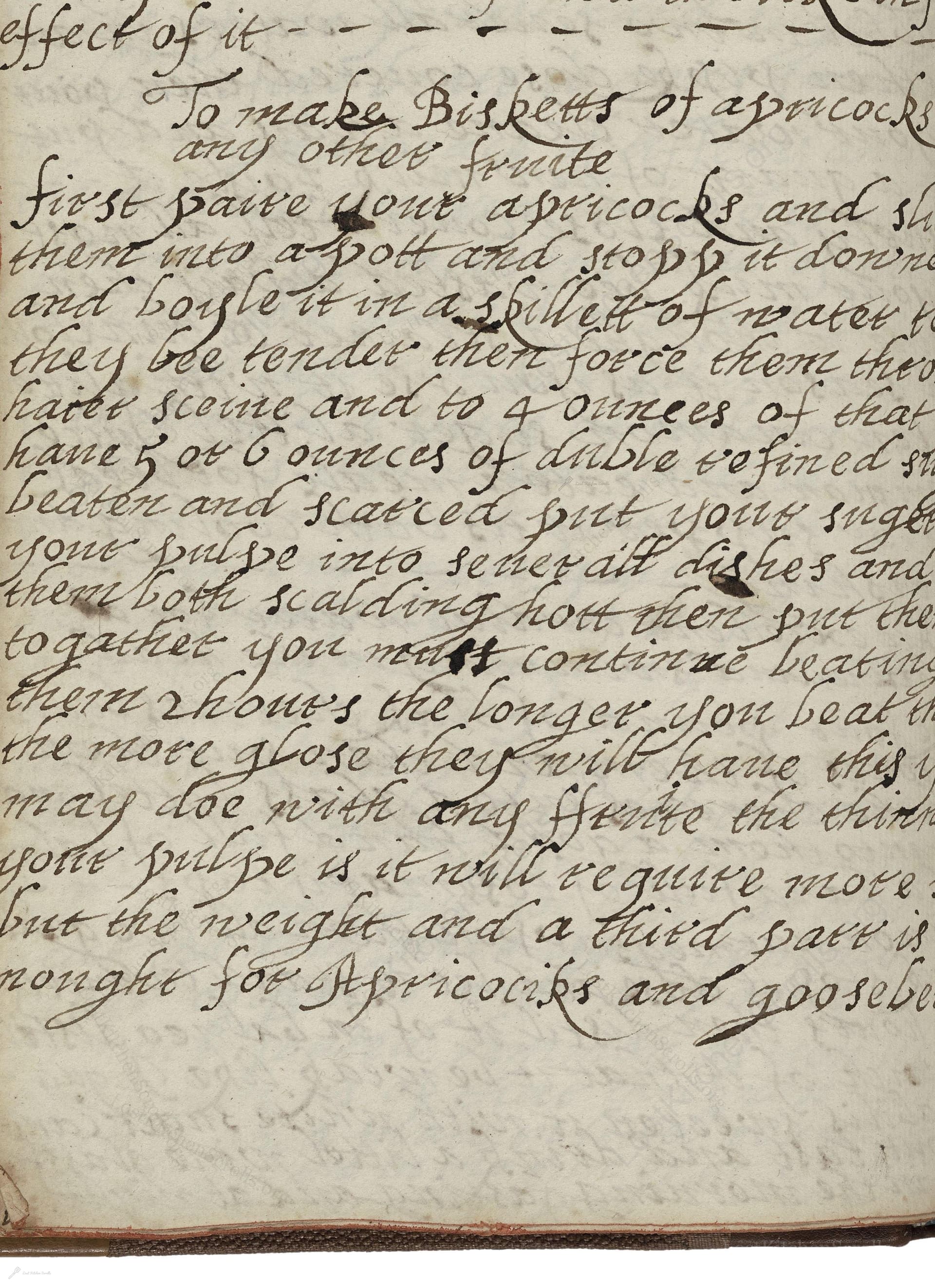To Make Bisketts Of Apricocks Or Other Fruite
From the treasured pages of Cookbook of Constance Hall
Written by Constance Hall

To Make Bisketts Of Apricocks Or Other Fruite
"first paires your apricocks and slice them into a pott and stopp it downe close and boyle it in a 3 quartt of water till they bee tender then force them through a hair scieve and to 4 ouncees of that pulpe have 5 or 6 ouncees of duble refined sugar beaten and scarced put your sugar into your pulpe into severall dishes and have them both scalding hott then putt them to gather you must continue beating them the longer you beat them the more glose they will have this you may doe with any fruite the thicker your pulpe is it will require more sugar but the weight and a third part is anough for Apricockks and gooseberrys"
Note on the Original Text
The recipe is written in the direct, practical style of 17th-century English household manuscripts: little punctuation, variable spelling (e.g., 'boyle', 'apricocks', 'scieve'), and few precise measurements beyond ratios. Instructions are embedded in long sentences, with actions to be inferred by the experienced cook. Words like 'bisketts' here refer not to modern biscuits, but to fruit pastes or confections. The script eschews exact temperatures or times, emphasizing visual and textural cues ('tender', 'scalding hott', 'the more glosse'). This allowed an adaptable approach suited to both varying fruit types and domestic conditions.

Title
Cookbook of Constance Hall (1672)
You can also click the book image above to peruse the original tome
Writer
Constance Hall
Era
1672
Publisher
Unknown
Background
A spirited foray into 17th-century kitchens, this collection by Constance Hall brims with the flavors, secrets, and delicacies of Restoration-era England—perfect for cooks keen to revive a dash of history in their modern menus.
Kindly made available by
Folger Shakespeare Library
This recipe is drawn from a 1672 manuscript belonging to Constance Hall, a gentlewoman living in Restoration England. At that time, sugar had become more widely available and preserving fruit in the form of 'bisketts' or fruit pastes was both fashionable and practical, providing a sweet treat long after the summer harvests had faded. The use of refined white sugar marks this as a luxury item, intended for special occasions or display among genteel company. Such delicacies were sometimes served with tea or used as edible gifts in grand households.

In the 17th century, this recipe would have been prepared in a heavy-bottomed copper or ceramic pot set over a low fire. The fruit was passed through a hair sieve (coarse mesh strainer made with animal hair) to yield a smooth purée. Sugar was crushed by hand using a mortar and pestle, then sifted. The beating of the mixture would be done with a sturdy wooden spoon or whisk, relying on sustained manual effort to achieve a glossy finish. The hot fruit paste was likely spread on shallow dishes or in small wooden molds to set.
Prep Time
20 mins
Cook Time
40 mins
Servings
10
We've done our best to adapt this historical recipe for modern kitchens, but some details may still need refinement. We warmly welcome feedback from fellow cooks and culinary historians — your insights support the entire community!
Ingredients
- 1 lb 2 oz apricots (other soft fruit like gooseberries, plums, or peaches may be substituted)
- 3 quarts water
- 5–6 oz superfine (caster) sugar per 4 oz fruit pulp (adjust to taste and fruit acidity)
Instructions
- To recreate these historical apricot 'bisketts' (a type of fruit paste or confection), begin by peeling (paring) and slicing fresh apricots (or any other desired fruit).
- Place about 1 lb 2 oz of fruit into a heatproof pot with a tight-fitting lid.
- Pour in approximately 3 quarts of water, seal the pot, and simmer gently until the fruit is soft and tender.
- Once cooked, press the fruit through a fine sieve to create a smooth pulp.
- For every 4 oz of fruit pulp, measure out 5–6 oz of superfine sugar (caster sugar), sifted.
- Heat the fruit pulp and sugar separately in their own bowls until both are scalding hot, then mix them together.
- Continuously beat the mixture (a stand mixer with a whisk attachment or a balloon whisk works well) – the longer you beat, the glossier the final paste.
- For firmer fruits or thinner purees, you may need a bit more sugar for a good 'set'.
- For apricots and gooseberries, a third again as much sugar by weight is sufficient.
- Spoon the glossy fruit paste into small molds or onto parchment to cool and set, forming jewel-like fruit 'bisketts'.:
Estimated Calories
150 per serving
Cooking Estimates
It takes about 20 minutes to prepare the ingredients, and around 40 minutes to cook the fruit until soft. The finished paste can be divided into 10 small servings. Each serving is about 150 calories, based on the fruit and sugar used in the recipe.
As noted above, we have made our best effort to translate and adapt this historical recipe for modern kitchens, taking into account ingredients nowadays, cooking techniques, measurements, and so on. However, historical recipes often contain assumptions that require interpretation.
We'd love for anyone to help improve these adaptations. Community contributions are highly welcome. If you have suggestions, corrections, or cooking tips based on your experience with this recipe, please share them below.
Join the Discussion
Rate This Recipe
Dietary Preference
Main Ingredients

Den Bockfisch In Einer Fleisch Suppen Zu Kochen
This recipe hails from a German manuscript cookbook compiled in 1696, a time whe...

Die Grieß Nudlen Zumachen
This recipe comes from a rather mysterious manuscript cookbook, penned anonymous...

Ein Boudain
This recipe comes from an anonymous German-language manuscript cookbook from 169...

Ein Gesaltzen Citroni
This recipe, dating from 1696, comes from an extensive anonymous German cookbook...
Browse our complete collection of time-honored recipes



